light Alfa Romeo GT 2007 Owner handbook (in English)
[x] Cancel search | Manufacturer: ALFA ROMEO, Model Year: 2007, Model line: GT, Model: Alfa Romeo GT 2007Pages: 271, PDF Size: 5.57 MB
Page 25 of 271

GETTING TO KNOW YOUR CAR
23
REAR-VIEW MIRROR
ADJUSTMENT
INNER
The mirror, fitted with a safety device that
causes it to be released in the event of a
violent crash, can be moved using the lever
(A-fig. 28) to two different positions, nor-
mal or antiglare.
fig. 28
A0A0039b
Folding(fig. 30)
– In the event of need (for example when
the mirror causes difficulty in narrow spaces)
it is possible to fold the mirror moving it from
position (A) to position (B).
fig. 30
A0A0041b
When driving the mirrors
should always be in posi-
tion (A).
As the driver’s wing mir-
ror is curved, it may slight-
ly alter the perception of
distance.
OUTER
Electric adjustment (fig. 29)
– use the switch (A) to select the mirror
required (right or left);
– pressing the button (B) in one of the
four directions, move the mirror selected pre-
viously;
– position the switch (A) in the interme-
diate locking position.
IMPORTANTAdjustment is possible on-
ly with the ignition key at MAR.
fig. 29
A0A0040b
Page 34 of 271
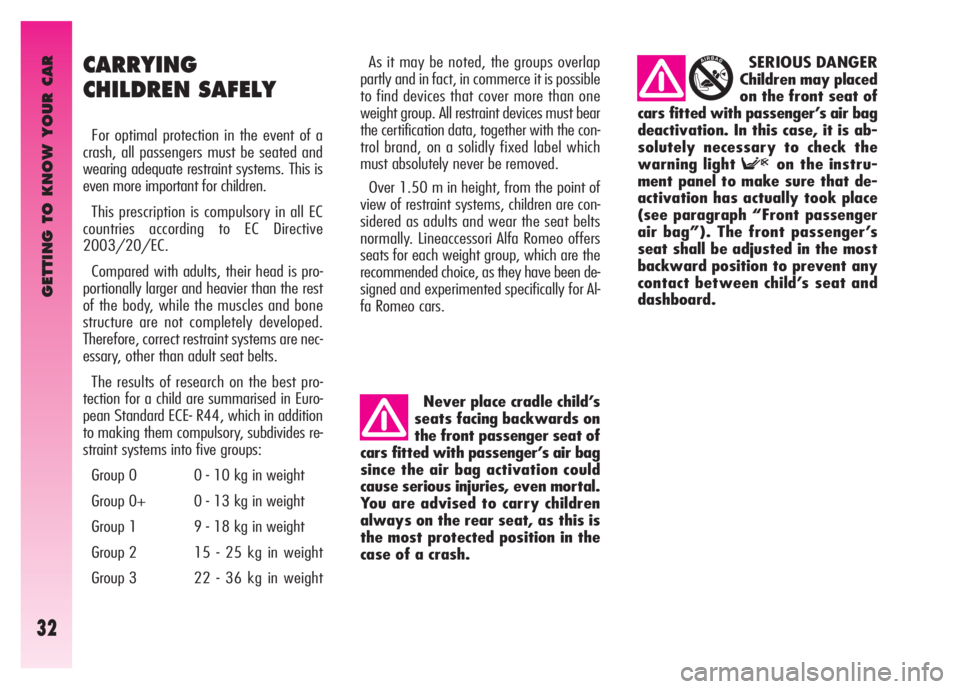
GETTING TO KNOW YOUR CAR
32
CARRYING
CHILDREN SAFELY
For optimal protection in the event of a
crash, all passengers must be seated and
wearing adequate restraint systems. This is
even more important for children.
This prescription is compulsory in all EC
countries according to EC Directive
2003/20/EC.
Compared with adults, their head is pro-
portionally larger and heavier than the rest
of the body, while the muscles and bone
structure are not completely developed.
Therefore, correct restraint systems are nec-
essary, other than adult seat belts.
The results of research on the best pro-
tection for a child are summarised in Euro-
pean Standard ECE- R44, which in addition
to making them compulsory, subdivides re-
straint systems into five groups:
Group 0 0 - 10 kg in weight
Group 0+ 0 - 13 kg in weight
Group 1 9 - 18 kg in weight
Group 2 15 - 25 kg in weight
Group 3 22 - 36 kg in weightAs it may be noted, the groups overlap
partly and in fact, in commerce it is possible
to find devices that cover more than one
weight group. All restraint devices must bear
the certification data, together with the con-
trol brand, on a solidly fixed label which
must absolutely never be removed.
Over 1.50 m in height, from the point of
view of restraint systems, children are con-
sidered as adults and wear the seat belts
normally. Lineaccessori Alfa Romeo offers
seats for each weight group, which are the
recommended choice, as they have been de-
signed and experimented specifically for Al-
fa Romeo cars.
Never place cradle child’s
seats facing backwards on
the front passenger seat of
cars fitted with passenger’s air bag
since the air bag activation could
cause serious injuries, even mortal.
You are advised to carry children
always on the rear seat, as this is
the most protected position in the
case of a crash.
SERIOUS DANGER
Children may placed
on the front seat of
cars fitted with passenger’s air bag
deactivation. In this case, it is ab-
solutely necessary to check the
warning light Fon the instru-
ment panel to make sure that de-
activation has actually took place
(see paragraph “Front passenger
air bag”). The front passenger’s
seat shall be adjusted in the most
backward position to prevent any
contact between child’s seat and
dashboard.
Page 38 of 271
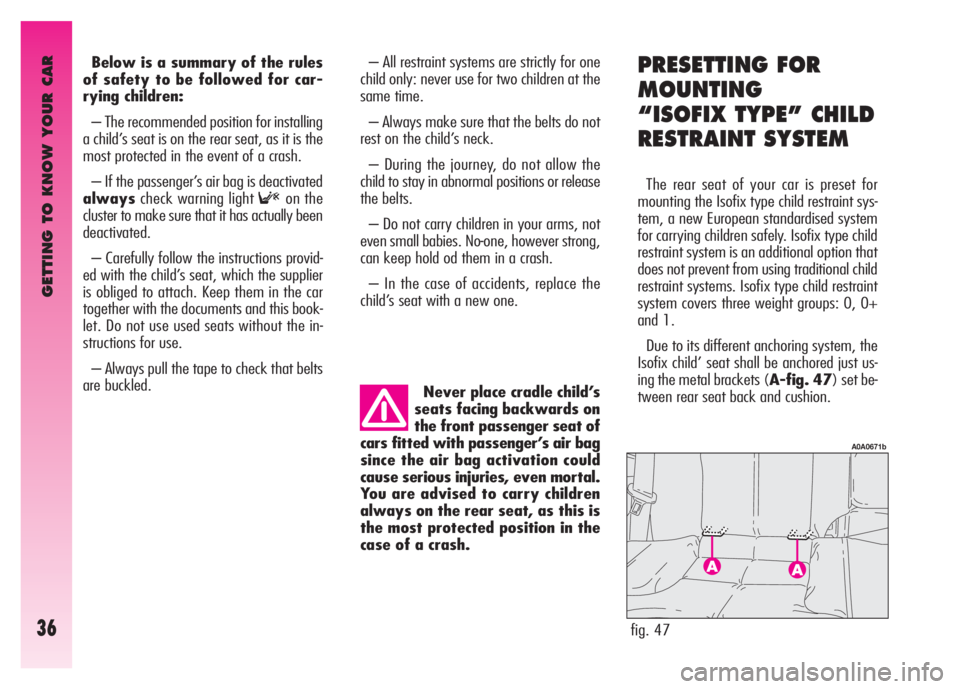
GETTING TO KNOW YOUR CAR
36
Below is a summary of the rules
of safety to be followed for car-
rying children:
– The recommended position for installing
a child’s seat is on the rear seat, as it is the
most protected in the event of a crash.
– If the passenger’s air bag is deactivated
alwayscheck warning light
Fon the
cluster to make sure that it has actually been
deactivated.
– Carefully follow the instructions provid-
ed with the child’s seat, which the supplier
is obliged to attach. Keep them in the car
together with the documents and this book-
let. Do not use used seats without the in-
structions for use.
– Always pull the tape to check that belts
are buckled.
Never place cradle child’s
seats facing backwards on
the front passenger seat of
cars fitted with passenger’s air bag
since the air bag activation could
cause serious injuries, even mortal.
You are advised to carry children
always on the rear seat, as this is
the most protected position in the
case of a crash.– All restraint systems are strictly for one
child only: never use for two children at the
same time.
– Always make sure that the belts do not
rest on the child’s neck.
– During the journey, do not allow the
child to stay in abnormal positions or release
the belts.
– Do not carry children in your arms, not
even small babies. No-one, however strong,
can keep hold od them in a crash.
– In the case of accidents, replace the
child’s seat with a new one.
PRESETTING FOR
MOUNTING
“ISOFIX TYPE” CHILD
RESTRAINT SYSTEM
The rear seat of your car is preset for
mounting the Isofix type child restraint sys-
tem, a new European standardised system
for carrying children safely. Isofix type child
restraint system is an additional option that
does not prevent from using traditional child
restraint systems. Isofix type child restraint
system covers three weight groups: 0, 0+
and 1.
Due to its different anchoring system, the
Isofix child’ seat shall be anchored just us-
ing the metal brackets (A-fig. 47) set be-
tween rear seat back and cushion.
fig. 47
A0A0671b
Page 42 of 271
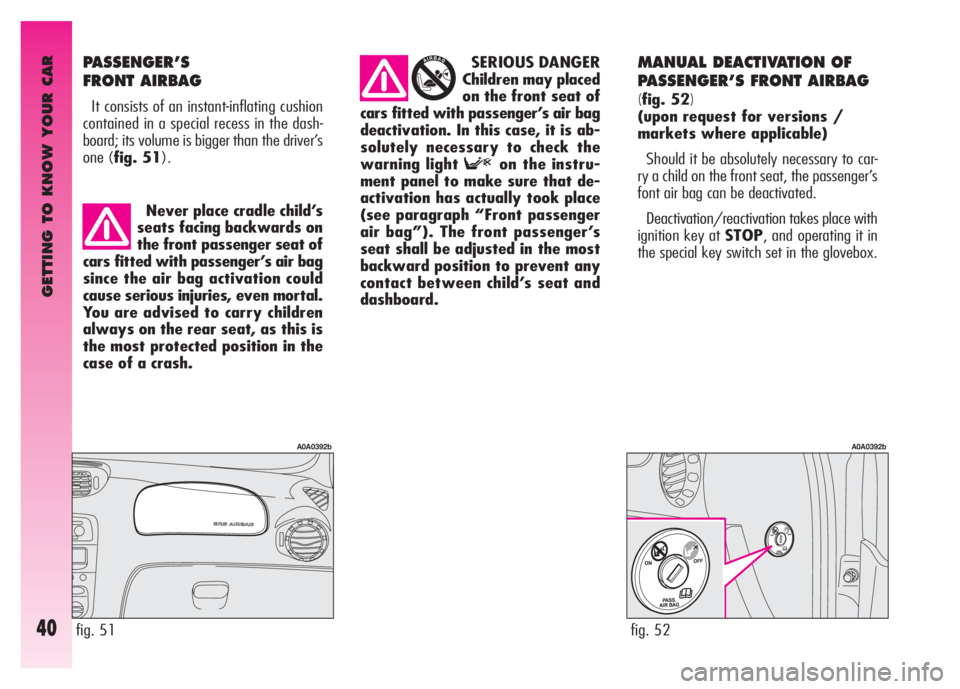
GETTING TO KNOW YOUR CAR
40
PASSENGER’S
FRONT AIRBAG
It consists of an instant-inflating cushion
contained in a special recess in the dash-
board; its volume is bigger than the driver’s
one (fig. 51).
MANUAL DEACTIVATION OF
PASSENGER’S FRONT AIRBAG
(
fig. 52)
(upon request for versions /
markets where applicable)
Should it be absolutely necessary to car-
ry a child on the front seat, the passenger’s
font air bag can be deactivated.
Deactivation/reactivation takes place with
ignition key at STOP, and operating it in
the special key switch set in the glovebox. SERIOUS DANGER
Children may placed
on the front seat of
cars fitted with passenger’s air bag
deactivation. In this case, it is ab-
solutely necessary to check the
warning light Fon the instru-
ment panel to make sure that de-
activation has actually took place
(see paragraph “Front passenger
air bag”). The front passenger’s
seat shall be adjusted in the most
backward position to prevent any
contact between child’s seat and
dashboard.
fig. 51
A0A0392b
fig. 52
A0A0392b
Never place cradle child’s
seats facing backwards on
the front passenger seat of
cars fitted with passenger’s air bag
since the air bag activation could
cause serious injuries, even mortal.
You are advised to carry children
always on the rear seat, as this is
the most protected position in the
case of a crash.
Page 43 of 271

GETTING TO KNOW YOUR CAR
41
The key can be inserted and removed in
both positions.
IMPORTANTOperate the switch only
when the engine is not running and the ig-
nition key is removed.
The key-operated switch has two positions:
– passenger’s front airbag activated (ON
positionP): warning light
Fon instru-
ment cluster off; it is absolutely prohibited
to carry a child on the front seat.
– passenger’s front airbag deactivated
(OFFposition
F): warning light Fon
instrument cluster on; it is possible to carry
a child protected by special restraint system
on the front seat.
The warning light
Fon the cluster stays
on permanently until the passenger’s air bag
is reactivated.
Deactivation of the passenger’s front air
bag does not inhibit operation of the side air
bag.
SIDE AIR BAGS
(SIDE BAG - WINDOW BAG)
SIDE BAG (
fig. 53)
The side bag is formed of an instanta-
neously-inflating cushion housed in the back
rest of the front seat and protects the chest
of occupants in case of a side crash of medi-
um-high severity.
WINDOW BAG (fig. 54)
The window bag is formed of two “cur-
tain” cushions housed in the side roof lining
covered by a special trim, which protects the
head of front and rear occupants in the event
of a side crash thanks to the wide cushion
inflation surface.
IMPORTANTIn the event of side crash,
you can obtain the best protection by the
system keeping a correct position on the
seat, thus allowing correct window bag un-
folding.
fig. 53
A0A0614b
fig. 54
A0A0615b
Page 45 of 271

GETTING TO KNOW YOUR CAR
43
GENERAL CAUTIONS
If when turning the ignition
key to MAR, the warning
light
¬does not turn on or
if it stays on when travelling there
could be a failure in safety sys-
tems; in this event air bags or pre-
tensioners could not trigger in case
of impact or, in a minor number of
cases, they could trigger acciden-
tally. Contact Alfa Romeo Autho-
rized Services immediately to have
the system checked.
Do not cover the backrest
of front seats with trims or
covers that are not suitable
to be used with side bags.Never travel with objects
on your lap, in front of
your chest or with a pipe,
pencil, etc. between your lips; in-
jury may result in the event of the
air bag being triggered.
Always keep your hands
on the steering wheel rim
when driving, so that if the
air bag is triggered, it can inflate
without meeting any obstacles
which could cause serious harm to
you. Do not drive with the body
bent forwards, keep the seat back
rest in the erect position and lean
your back well against it.
If the car has been stolen
or an attempt to steal it
has been made, if it has
been subjected to vandals or
floods, have the air bag system
checked by Alfa Romeo Authorized
Services.
Remember that with the
key engaged and at MAR,
even if the engine is not
running, the air bags may be trig-
gered on a stationary car if it is
bumped by another moving car.
Therefore, never seat children on
the front seat even when the car is
stationary. On the other hand re-
member that if the key is at STOP,
no safety system (air bags or pre-
tensioners) is triggered in the
event of an impact; in this case,
failure to come into action cannot
be considered as a sign that the
system is not working properly.
Page 46 of 271

GETTING TO KNOW YOUR CAR
44
STEERING WHEEL
LEVERS
The devices and services controlled by the
levers on the steering wheel can only be ac-
tivated with the ignition key at MAR.
LEFT-HAND LEVER
The left-hand lever controls the outer lights
except for the fog lamps and rear fog
guards.
When the outer lights are switched on, the
various controls on the dashboard are illu-
minated.
Only with the ignition key at PARK, re-
gardless of the position of the knurled ring,
the sidelights and number plate lights stay on.
Position (1or2-fig. 60) of the lever
causes the turning on only of the sidelights
(front and rear), on the right or left respec-
tively.
Lights switched off
(fig. 55)
When the pointer in the knurled ring is op-
posite the symbol O, the outer lights are
switched off. When the ignition key is
turned to MAR, the warn-
ing light
F(with passen-
ger’s front air bag deactivation
switch at ON) turns on and flash-
es for few seconds to remind that
passenger’s air bag will be de-
ployed in a crash, after which it
should go off.The front air bag is trig-
gered for shocks greater in
magnitude than the pre-
tensioners. For impacts between
these two thresholds, it is there-
fore normal that only the preten-
sioners are triggered.
Do not hook rigid objects
to the coat hooks and to
the support handles.
The air bag does not sub-
stitute the seat belts, but
only increases their effec-
tiveness. Moreover, since the front
air bags do not come into operation
in the event of front impact at low
speed, side collisions, bumps from
behind or overturning, in these cir-
cumstances the occupants would
only be protected by the seat belts
which must therefore always be
fastened. Never wash seat back-
rests with pressurised wa-
ter or steam (by hand or at
automatic seat washing stations).
Page 47 of 271
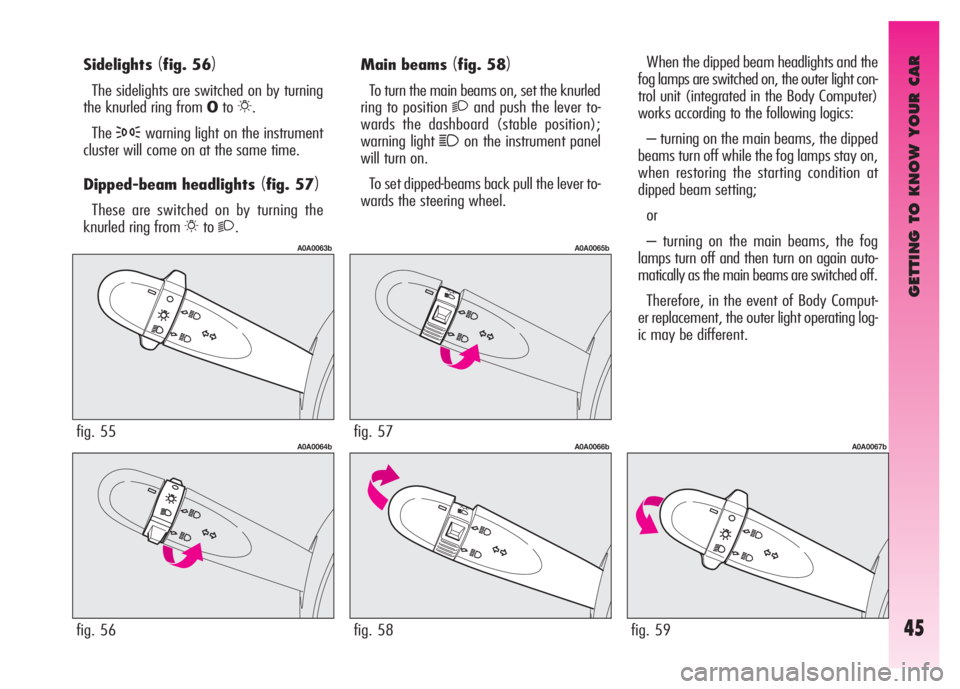
GETTING TO KNOW YOUR CAR
45
Sidelights(fig. 56)
The sidelights are switched on by turning
the knurled ring from Oto
6.
The
3warning light on the instrument
cluster will come on at the same time.
Dipped-beam headlights
(fig. 57)
These are switched on by turning the
knurled ring from
6to2.
fig. 55
A0A0063b
fig. 56
A0A0064b
Main beams (fig. 58)
To turn the main beams on, set the knurled
ring to position
2and push the lever to-
wards the dashboard (stable position);
warning light
1on the instrument panel
will turn on.
To set dipped-beams back pull the lever to-
wards the steering wheel.
fig. 57
A0A0065b
fig. 58
A0A0066b
When the dipped beam headlights and the
fog lamps are switched on, the outer light con-
trol unit (integrated in the Body Computer)
works according to the following logics:
– turning on the main beams, the dipped
beams turn off while the fog lamps stay on,
when restoring the starting condition at
dipped beam setting;
or
– turning on the main beams, the fog
lamps turn off and then turn on again auto-
matically as the main beams are switched off.
Therefore, in the event of Body Comput-
er replacement, the outer light operating log-
ic may be different.
fig. 59
A0A0067b
Page 48 of 271
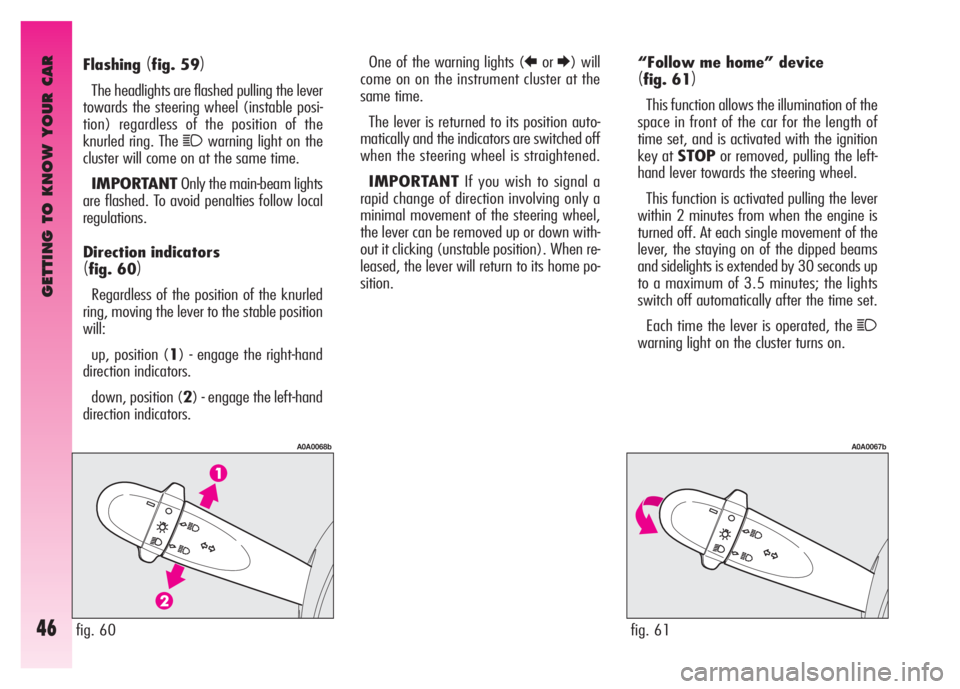
GETTING TO KNOW YOUR CAR
46
“Follow me home” device
(fig. 61)
This function allows the illumination of the
space in front of the car for the length of
time set, and is activated with the ignition
key at STOPor removed, pulling the left-
hand lever towards the steering wheel.
This function is activated pulling the lever
within 2 minutes from when the engine is
turned off. At each single movement of the
lever, the staying on of the dipped beams
and sidelights is extended by 30 seconds up
to a maximum of 3.5 minutes; the lights
switch off automatically after the time set.
Each time the lever is operated, the
1
warning light on the cluster turns on. Flashing
(fig. 59)
The headlights are flashed pulling the lever
towards the steering wheel (instable posi-
tion) regardless of the position of the
knurled ring. The
1warning light on the
cluster will come on at the same time.
IMPORTANTOnly the main-beam lights
are flashed. To avoid penalties follow local
regulations.
Direction indicators
(fig. 60)
Regardless of the position of the knurled
ring, moving the lever to the stable position
will:
up, position (1) - engage the right-hand
direction indicators.
down, position (2) - engage the left-hand
direction indicators.One of the warning lights (
RorE) will
come on on the instrument cluster at the
same time.
The lever is returned to its position auto-
matically and the indicators are switched off
when the steering wheel is straightened.
IMPORTANTIf you wish to signal a
rapid change of direction involving only a
minimal movement of the steering wheel,
the lever can be removed up or down with-
out it clicking (unstable position). When re-
leased, the lever will return to its home po-
sition.
fig. 61
A0A0067b
fig. 60
A0A0068b
Page 51 of 271
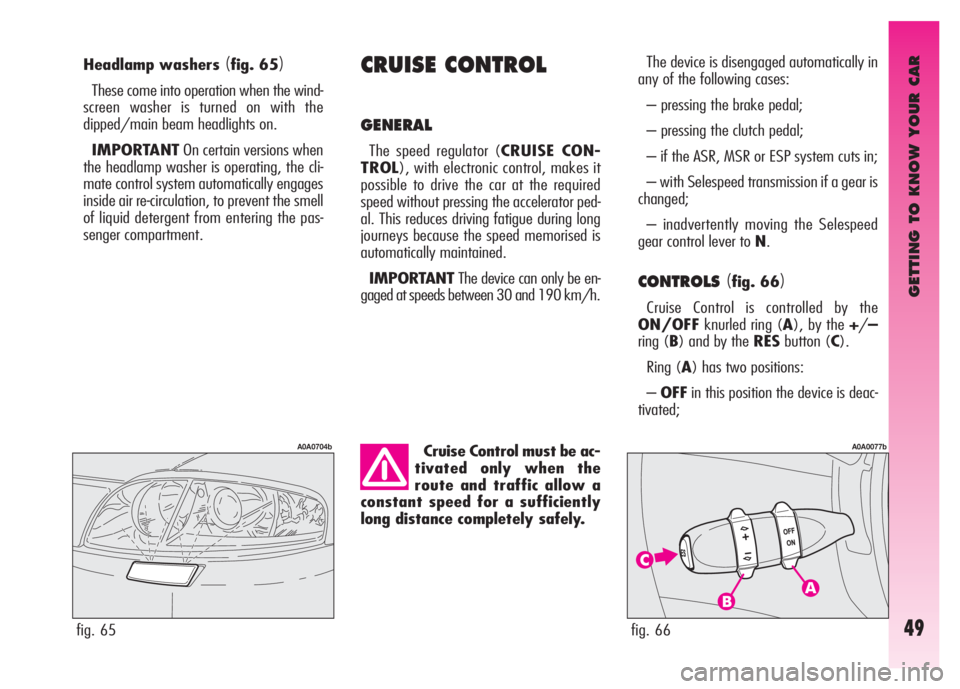
GETTING TO KNOW YOUR CAR
49
Headlamp washers (fig. 65)
These come into operation when the wind-
screen washer is turned on with the
dipped/main beam headlights on.
IMPORTANTOn certain versions when
the headlamp washer is operating, the cli-
mate control system automatically engages
inside air re-circulation, to prevent the smell
of liquid detergent from entering the pas-
senger compartment.
CRUISE CONTROL
GENERAL
The speed regulator (CRUISE CON-
TROL), with electronic control, makes it
possible to drive the car at the required
speed without pressing the accelerator ped-
al. This reduces driving fatigue during long
journeys because the speed memorised is
automatically maintained.
IMPORTANTThe device can only be en-
gaged at speeds between 30 and 190 km/h.
fig. 65
A0A0704bCruise Control must be ac-
tivated only when the
route and traffic allow a
constant speed for a sufficiently
long distance completely safely.
The device is disengaged automatically in
any of the following cases:
– pressing the brake pedal;
– pressing the clutch pedal;
– if the ASR, MSR or ESP system cuts in;
– with Selespeed transmission if a gear is
changed;
– inadvertently moving the Selespeed
gear control lever to N.
CONTROLS(fig. 66)
Cruise Control is controlled by the
ON/OFFknurled ring (A), by the +/–
ring (B) and by the RESbutton (C).
Ring (A) has two positions:
–OFFin this position the device is deac-
tivated;
fig. 66
A0A0077b